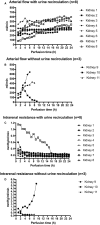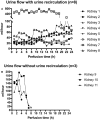Twenty-four-hour normothermic perfusion of discarded human kidneys with urine recirculation
- PMID: 29758129
- PMCID: PMC6491986
- DOI: 10.1111/ajt.14932
Twenty-four-hour normothermic perfusion of discarded human kidneys with urine recirculation
Erratum in
-
Erratum.Am J Transplant. 2021 Apr;21(4):1675. doi: 10.1111/ajt.16521. Am J Transplant. 2021. PMID: 33788995 Free PMC article. No abstract available.
Abstract
Transportable normothermic kidney perfusion for 24 hours or longer could enable viability assessment of marginal grafts, increased organ use, and improved transplant logistics. Eleven clinically declined kidneys were perfused normothermically, with 6 being from donors after brain death (median cold ischemia time 33 ± 36.9 hours) and 5 being from donors after circulatory death (36.2 ± 38.3 hours). Three kidneys were perfused using Ringer's lactate to replace excreted urine volume, and 8 kidneys were perfused using urine recirculation to maintain perfusate volume without fluid replenishment. In all cases, normothermic perfusion either maintained or slightly improved the histopathologically assessed tubular condition, and there was effective urine production in kidneys from both donors after brain death and donors after circulatory death (2367 ± 1798 mL vs 744.4 ± 198.4 mL, respectively; P = .44). Biomarkers, neutrophil gelatinase-associated lipocalin, and kidney injury molecule-1 were successfully detected and quantified in the perfusate. All kidneys with urine recirculation were readily perfused for 24 hours (n = 8) and exhibited physiological perfusate sodium levels (140.7 ± 1.2 mmol/L), while kidneys without urine recirculation (n = 3) achieved a reduced normothermic perfusion time of 7.7 ± 1.5 hours and significantly higher perfusate sodium levels (159.6 ± 4.63 mmol/:, P < .01). Normothermic machine perfusion of human kidneys for 24 hours appears to be feasible, and urine recirculation was found to facilitate the maintenance of perfusate volume and homeostasis.
Keywords: clinical research/practice; kidney (native) function/dysfunction; kidney transplantation/nephrology; organ perfusion and preservation; translational research/science.
© 2018 The Authors. American Journal of Transplantation published by Wiley Periodicals, Inc. on behalf of The American Society of Transplantation and the American Society of Transplant Surgeons.
Figures






References
-
- Treckmann J, Moers C, Smits JM, et al. Machine perfusion versus cold storage for preservation of kidneys from expanded criteria donors after brain death. Transpl Int. 2011;24:548‐554. - PubMed
-
- Moers C, Smits JM, Maathuis MH, et al. Machine perfusion or cold storage in deceased‐donor kidney transplantation. N Engl J Med. 2009;360:7‐19. - PubMed
-
- Kron P, Schlegel A, de Rougemont O, Oberkofler CE, Clavien PA, Dutkowski P. Short, cool, and well oxygenated – HOPE for kidney transplantation in a rodent model. Ann Surg. 2016;264:815‐822. - PubMed
-
- Nicholson ML, Hosgood SA. Renal transplantation after ex vivo normothermic perfusion: the first clinical study. Am J Transplant. 2013;13:1246‐1252. - PubMed
Publication types
MeSH terms
Substances
Grants and funding
- II-ES-1010-10096/UK's National Institute for Health Research/International
- EP/L024012/1/Oxford Centre for Drug Delivery Devices (OxCD3)/International
- Engineering and Physical Sciences Research Council/International
- II-ES-1010-10096/DH_/Department of Health/United Kingdom
- NIHR200022/DH_/Department of Health/United Kingdom
LinkOut - more resources
Full Text Sources
Other Literature Sources
Medical
Miscellaneous

